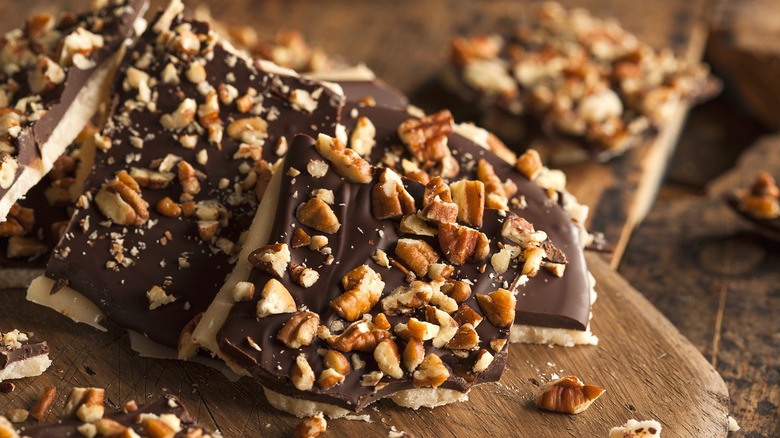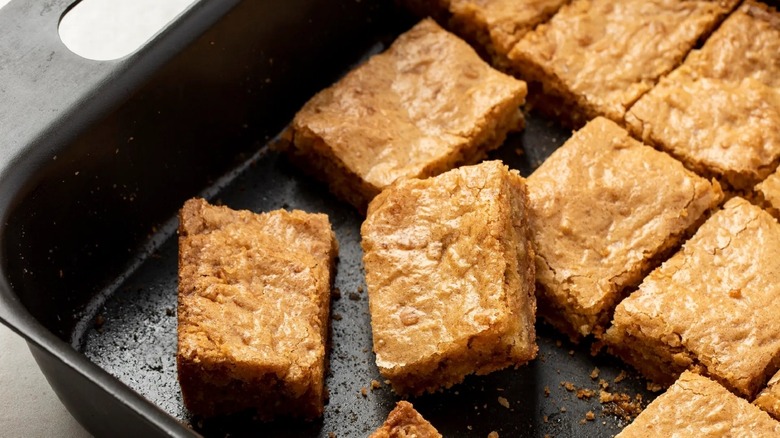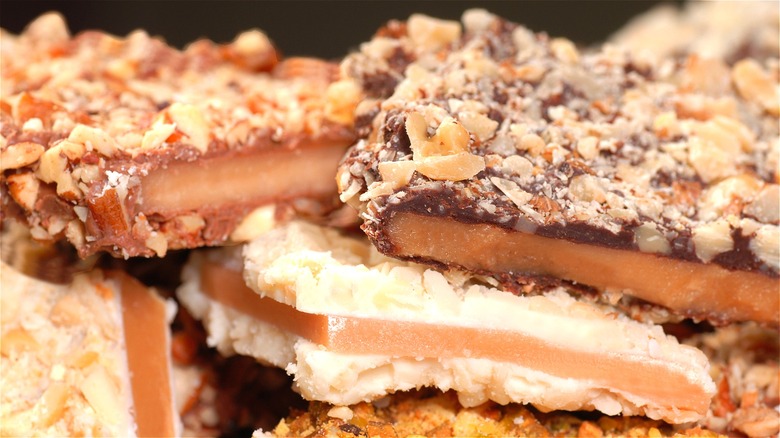The Fork Scoring Technique For Perfectly Cut Toffee Pieces
In the realm of homemade sugary delights, toffee is an easy confection can be customized to fit your current cravings. The difference between toffee and caramel has everything to do with consistency. Those in the mood for a hearty crunch instead of a chewy treat should look past caramel and try DIY hard toffee, made with only white or brown sugar and butter that sets into a brittle-like, easy-to-break confection. However, while the rustic look of jagged toffee chunks is fine for some, you might want to create perfectly uniform squares to give as gifts — a difficult task, unless you score the still-warm candy first.
Once toffee is cooked to the "hard boil" stage in a pot (and yes, a candy thermometer is important for telling when), it is poured into a lined pan or baking sheet and left to cool until hardened. To set the stage for evenly-divided pieces, once your toffee begins to cool and takes on a thicker consistency, use a knife to make indents on the surface. Once it's fully set, you should be able to easily break it apart into even squares. The only tricky part is determining when your candy is cool enough to hold its shape once scored. Luckily, a popular and easy method can tell you if your confection is the right consistency for sectioning. All you need is a handy kitchen fork.
How to make uniform toffee pieces with a fork and knife
In the Instagram video below, user @onesweetmama demonstrates how to tell if your sheet of toffee is perfect for storing. She starts off by poking a tray of cooled almond toffee with a fork to test the texture.
Once the indents of the fork marks stay in place, instead of vanishing from the toffee, she easily scores the candy with a knife. After your toffee has been poured into a lined pan, you can try the fork test after 5 minutes of setting. Toffee takes roughly 20 minutes to harden, so make sure not to wait too long, or it will be too hard to score. If the fork marks disappear, wait another few minutes before testing again. You want the toffee to have a malleable texture that isn't too sticky or runny.
When it's time to score the candy, you can use a knife or even a pizza cutter if you want straighter lines. From there, all you have to do is wait for it to fully harden and then snap it into pieces, and you've got perfect plain toffee. If you want to make dark chocolate butter toffee, though, or perhaps squares loaded with toppings like fruit and sprinkles, scoring can also make it easier to add sweet fixings to this treat.
The benefit of scoring toffee ahead of time
The fork-testing technique help you customize your toffee with ease. If you enjoy toffee with a layer of chocolate on top, testing the texture helps you determine when to pour on the chocolate. Partially-set toffee, rather than candy that's too soft, can support the chocolate on its surface without sinking. Perforating your pan of candy before adding melted chocolate should also help it sink into the lines, making for easy breakage.
Scoring can also help you add several different decorations on one pan of toffee. Suppose you're making it for friends and want to offer some pieces with nuts, others with chocolate, and a few with dried fruit or sprinkles. In that case, just score it into pieces and scatter different toppings on each square before it fully hardens. You can lightly press the toppings into the not-yet-set toffee. You can also adding toppings in small, neat sections on the parchment before pouring the hot toffee on top. This can help the additions embed themselves deeper in the candy.
With all of this being said, toffee is hard to break with perfectly straight edges, so while scoring will help a lot, this isn't really a treat that's meant to look flawlessly neat. While not every outlined piece of toffee may break with clean lines, your final product will still look a lot more uniform, and better yet, it will always be delicious.


